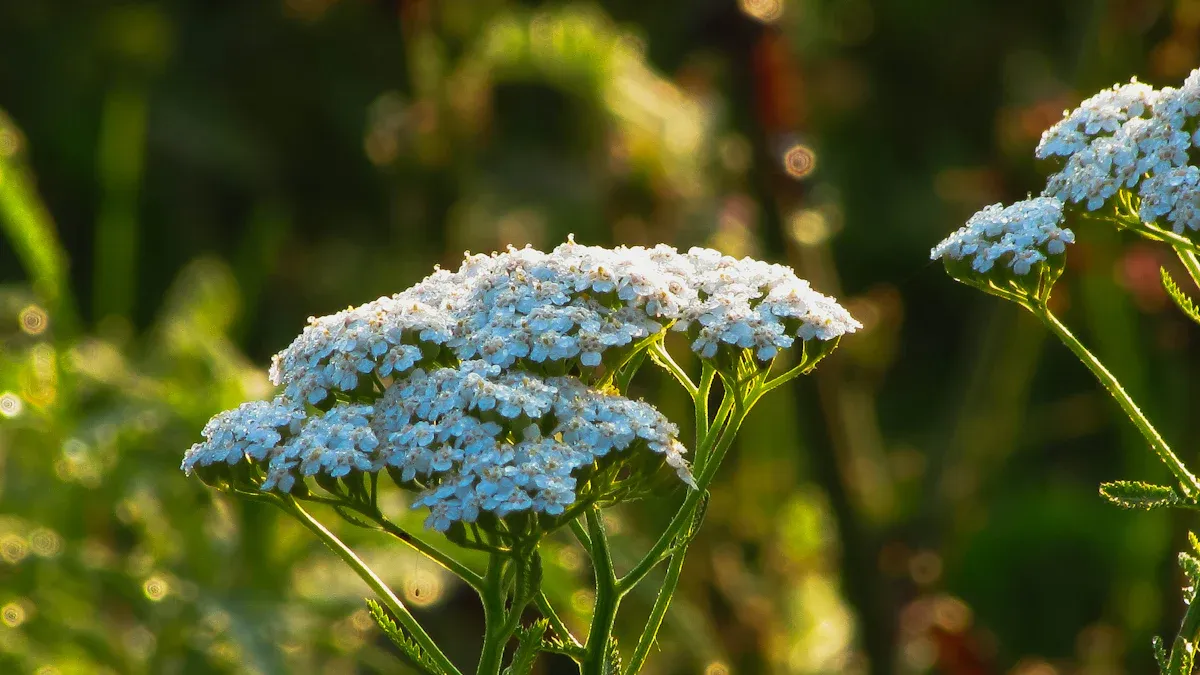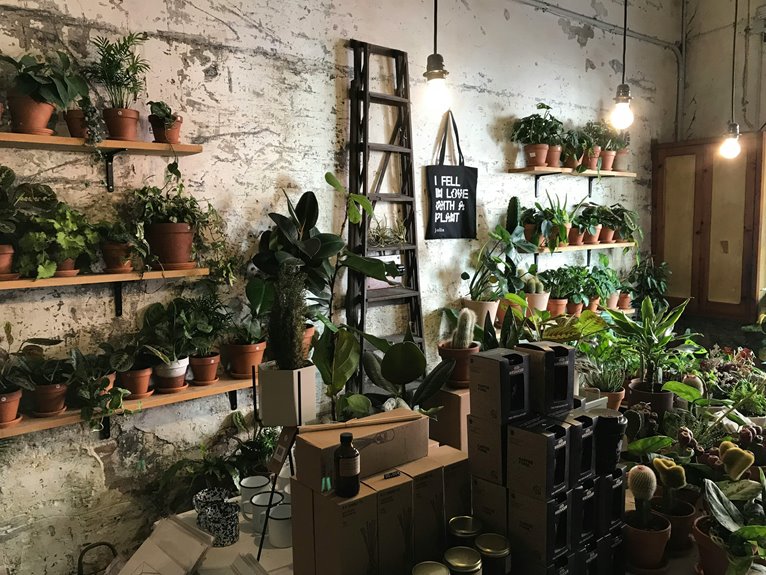
If your yarrow plant is drooping, it’s crucial to identify the underlying issues. Common causes of yarrow plant drooping include overwatering, underwatering, and poor soil quality. Understanding these factors can help you provide better yarrow plant care and restore your plant’s health.
Key Takeaways
Overwatering is a common cause of drooping in yarrow plants. Look for yellowing leaves and mushy stems as signs.
Underwatering can also lead to drooping. Check for crispy leaves and stunted growth to identify this issue.
Soil quality is crucial for yarrow health. Test your soil and add organic matter to improve drainage and nutrient levels.
Overwatering

Overwatering is one of the most common reasons for yarrow plant drooping. When you give your yarrow too much water, it can lead to serious problems.
Signs of Overwatering
You can spot overwatering by looking for these signs:
Yellowing Leaves: If the leaves turn yellow and start to drop, it’s a clear sign that your yarrow is getting too much water.
Wilting: Ironically, overwatered plants can also wilt. This happens because the roots can’t get enough oxygen.
Mushy Stems: If the stems feel soft or mushy, it’s a sign of root rot, which is often caused by excessive moisture.
Remember, yarrow plants thrive in well-drained soil. If you have clay soil, it can hold too much water, leading to waterlogged conditions. This suffocates the roots and can cause them to die. Here’s how it works:
Clay soil drains poorly, leading to waterlogged conditions that suffocate roots.
Oxygen deprivation from saturated soil causes roots to die.
Anaerobic conditions foster harmful bacteria and root rot, which can lead to sudden plant collapse.
Solutions for Overwatering
To help your yarrow recover from overwatering, consider these solutions:
Check Soil Drainage: Ensure your pot or garden bed has good drainage. If water pools at the bottom, it’s time to change your setup.
Adjust Watering Schedule: Water your yarrow only when the top inch of soil feels dry. In hot weather, you might need to water more frequently, but always check first.
Improve Soil Quality: Adding organic matter can help improve drainage. Here are some effective methods:
Method | Description |
|---|---|
Organic Matter Addition | Adding 1-2% organic matter yearly helps improve moisture retention and manage water effectively. |
Layered Amendments | Using worm castings, coconut coir, and biochar-compost can reduce watering frequency by 35%. |
Liquid Treatments | Monthly application of compost tea and liquid seaweed enhances soil structure and moisture retention. |
Monitor Climate Conditions: Adjust your watering based on the weather. For example, during cooler months, reduce watering to prevent root rot. Here’s a quick guide:
Climate Condition | Watering Frequency |
|---|---|
General Conditions | Once or twice a week |
Hot Weather | Increase frequency |
Winter | Water just enough to keep soil damp |
Temperate/Coastal Areas | Slightly increase frequency |
Cooler Months | Reduce watering to prevent root rot |
By following these tips, you can help your yarrow thrive and avoid the drooping that comes from overwatering.
Underwatering
Underwatering can also cause your yarrow plant to droop. When yarrow doesn’t receive enough water, it struggles to maintain its structure and health. Insufficient moisture leads to stress, which can result in wilting and drooping leaves.
Signs of Underwatering
You can identify underwatering by looking for these signs:
Crispy Leaves: If the leaves feel dry and brittle, your yarrow is likely thirsty.
Wilting: Unlike overwatering, wilting from underwatering makes the leaves droop without yellowing.
Stunted Growth: If your yarrow isn’t growing as expected, it might not be getting enough water.
When yarrow plants experience drought stress, they undergo physiological changes. For instance, certain compounds in the plant decrease, affecting its overall health. Here’s a quick look at how drought stress impacts yarrow:
Compound | Effect under Drought Stress |
|---|---|
Luteolin | Continually reduced |
Apig-7-glucoside | Major compound, affected but showed some increase over time |
Caffeic acid | Decreased until 180 days after germination, then increased |
Umbelliferon | Decreased until 180 days after germination, then increased |
Solutions for Underwatering
To help your yarrow thrive, follow these tips for proper watering practices:
Water Regularly: Newly planted yarrow needs at least 1 inch of water weekly. Spread this over 2-3 sessions to encourage deeper root growth.
Adjust for Established Plants: Once established, you can reduce watering to once a week or less, depending on rainfall. If summer rains occur, you might not need to water at all.
Consider Your Region: Different climates require different watering strategies. Here’s a quick guide:
Region | Watering Frequency | Notes |
|---|---|---|
Arid | At least 1 inch of water per week | Spread over 2-3 sessions; encourages deeper root growth for drought resistance. |
Established | Once a week or longer | If summer rains occur, supplemental watering may not be necessary. |
Temperate | ½ inch of water weekly until established | Avoid overwatering; prefers well-drained soil to prevent root rot. |
Mulch: Adding mulch around your yarrow can help retain soil moisture, especially in drier conditions. This simple step can make a big difference in keeping your plants hydrated.
By following these tips, you can prevent your yarrow plant from drooping due to underwatering and ensure it remains healthy and vibrant.
Soil Quality

Soil quality plays a vital role in the health of your yarrow plants. Nutrient-rich soil provides the essential elements that yarrow needs to thrive. When your soil is healthy, it supports strong root development and encourages vibrant blooms. Poor soil can lead to drooping and stunted growth, so it’s crucial to pay attention to what’s beneath the surface.
Importance of Soil Quality
Good soil quality means your yarrow can access nutrients and water more effectively. It also helps with drainage, preventing issues like root rot. Healthy soil fosters beneficial microorganisms that contribute to plant health. Without these, your yarrow may struggle to grow and flourish.
Improving Soil Conditions
You can easily improve your soil conditions with a few simple steps:
Test Your Soil: Start by testing your soil’s pH and nutrient levels. This will help you understand what your yarrow needs.
Add Organic Matter: Incorporate compost or well-rotted manure into your soil. This boosts nutrient levels and improves drainage.
Use Mulch: Applying a layer of mulch helps retain moisture and suppress weeds. It also adds organic matter as it breaks down.
Rotate Crops: If you grow other plants, rotate them with yarrow. This practice helps prevent nutrient depletion and pest buildup.
By focusing on soil quality, you can ensure your yarrow plants stay healthy and vibrant, avoiding drooping and other issues.
Pest Problems
Pest problems can lead to drooping in your yarrow plants. Identifying these pests early can save your plants from serious damage. Let’s take a look at some common pests that might be causing issues.
Common Pests
You might encounter several pests that affect yarrow, including:
Aphids: These tiny insects suck sap from the leaves, causing wilting and yellowing.
Spider Mites: These pests create fine webs and can cause leaf discoloration.
Caterpillars: They munch on leaves and can quickly defoliate your plants.
Managing Pests
Managing pests effectively can help keep your yarrow healthy. Here are some strategies you can use:
Introduce Beneficial Insects: Certain insects can help control pest populations. For example, ladybugs target aphids and other soft-bodied pests, while lacewings can tackle caterpillars and mealybugs. Here’s a quick reference table:
Beneficial Insect | Target Pests |
|---|---|
Ladybugs | Aphids, soft-bodied pests |
Lacewings | Aphids, caterpillars, mealybugs |
Parasite Wasps | Caterpillars, whiteflies, beetle larvae |
Use Organic Methods: You can manage pests without harmful chemicals. Consider these options:
Allow the soil to dry out to deter pests.
Use sticky traps to catch flying insects.
Handpick pests off your plants.
Chemical Options: If pests persist, you might consider chemical treatments. These include insecticidal sprays and soil drenches. However, keep in mind that organic methods are often safer for beneficial organisms and promote a healthier garden ecosystem.
By staying vigilant and using these management strategies, you can tackle yarrow plant problems effectively and keep your plants thriving.
Environmental Stress
Yarrow plants can experience drooping due to environmental stress, particularly from temperature and light conditions. Extreme heat or cold can affect their health. If your yarrow is exposed to high temperatures without enough water, it may struggle to thrive. Similarly, inadequate light can lead to weak growth and drooping leaves.
Temperature and Light
To keep your yarrow healthy, ensure it gets the right amount of sunlight. Aim for 6-8 hours of full sun daily. This exposure is crucial for healthy growth. During the summer months, protect your yarrow from heat stress by following these tips:
Check soil moisture regularly and provide deep watering if necessary.
Create shade during the hottest part of the day by moving potted plants or using shade cloth, umbrellas, or bedsheets.
Use lightweight materials to shield delicate plants from direct sunlight.
Regularly inspect potted plants and hanging baskets for dryness.
Mitigating Stress
You can take several steps to mitigate environmental stress for your yarrow plants:
Use Humidifiers: Place a humidifier nearby to increase local humidity.
Group Plants: Clustering your plants can create a microenvironment with higher humidity.
Pebble Trays: Set up a pebble tray to boost humidity without risking waterlogging.
Air Circulation Techniques: Use fans to improve air circulation and prevent mold in high humidity.
Choose the Right Potting Mix: Select a well-draining potting mix to prevent excess moisture retention.
Research shows that applying spermidine can also help yarrow plants cope with stress. In studies, yarrow treated with spermidine showed improved resilience against salinity stress. This treatment reduced electrolyte leakage and increased photosynthetic pigments, helping your plants stay healthy even under challenging conditions.
By paying attention to temperature and light, you can prevent yarrow plant problems and keep your garden thriving.
Taking care of your yarrow plants is essential for their health. Regularly check soil moisture, monitor for pests, and ensure they get enough sunlight. By following these tips, you can prevent drooping and enjoy vibrant blooms. Remember, a little attention goes a long way in keeping your yarrow thriving! 🌼
FAQ
What causes my yarrow plant to droop?
Drooping can result from overwatering, underwatering, poor soil quality, pests, or environmental stress like extreme temperatures.
How often should I water my yarrow?
Water your yarrow once a week, or more frequently in hot weather. Always check the soil moisture first.
Can I revive a drooping yarrow plant?
Yes! Adjust watering, improve soil quality, and check for pests. With proper care, your yarrow can bounce back. 🌱


